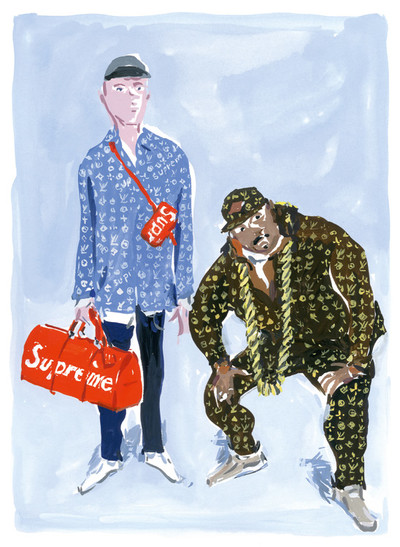Why the Supreme-Louis Vuitton menswear collab is pure 1990s hip-hop.
By Jon Caramanica
Illustration by Jean-Philippe Delhomme
Why the Supreme-Louis Vuitton menswear collab is pure 1990s hip-hop.

Being a hip-hop fan in the 1980s and early 1990s meant having a front-row seat to the most vital cultural transformation of our time. There was the music, of course, putting an end to the primacy of the guitar. And the politics, which gave antagonism and scepticism an appealing sheen. And then there was style, building an aesthetic from the ground up, long before street style was a well-curated series of poses and an object of mainstream obsession.
In an era before hip-hop mall-fashion lines, and later, hip-hop-enhanced runway collections, I just had to figure it out, cobbling together a look from pre-existing options: a boxy Carhartt jacket here, some tapered Girbaud jeans there, maybe a pair of not-too-broken-in Filas. Hip-hop honed my ear, my mind, my politics and my heart, but it also made me a sharp-eyed, detail-obsessed shopper.
When I became a music journalist and critic, I realized quickly that the job – done right – involved writing about more than just sound. Hip-hop proposed a whole worldview – cocky, oppositional, sometimes pugnacious and unerringly confident. It was impossible to detach the words and music from the presentation – an outfit choice could be just as potent a statement as a song – which meant that I was a style writer long before it was part of my actual job.
I came to the New York Times as a pop-music critic after years of writing for music magazines, but I’d always kept a longing eye on the paper’s Critical Shopper column. I knew there was a story to tell about clothes that was parallel to the one I was telling about music, even if traditional fashion writers hadn’t yet taken notice.
A couple of years later, in 2010, I got the opportunity to take over the column, and tried to make that point quickly: my first one was about Dave’s, a workwear store, chosen in combination of sincere spirit and a desire to deflate the slick blue-collar fetishism that was dominating the menswear conversation at the time. Plus, by that point I’d been wearing Carhartt for two decades – the idea that menswear was anointing high-fashion workwear, while ignoring the roots seemed ludicrous and pious.
Being an outsider was helpful; I didn’t hold as holy the prevailing aesthetic narratives or the market forces that buoyed them. The column – intended to be a retail survey – ended up as an ongoing conversation about the radical upheaval in men’s fashion that’s defined the 2010s, both in design terms, but more so in terms of who was included in the conversation. That the column takes place at store level – the place where a consumer might touch, try on, and perhaps, buy an item of clothing – removes the arguments from the philosophical realm to the tangible one.
Which brings me back to my earliest attempts at personal style. I, like so many others, found a way to invent myself through fashion, and not from the top down, but rather through borrowing, reframing, and hit-and-miss reimagining. Hip-hop said that you didn’t have to be part of the dominant culture to use a piece of it, to wear it in a way that made sense to you and flipped the bird at convention.
Sure enough, as the years have gone by, that approach has itself moved closer to the centre of the fashion conversation. Unlike the celebrities who crashed the front row a couple of decades ago, succubi who caught the draught of fashion’s aesthetic authority but added little to the conversation, hip-hop came with a fully formed taste profile, a commitment to disruption, and a firm belief that it should be accepted on its own terms.
And now the fashion world is beginning to reflect those values – sometimes with enthusiasm, sometimes with reluctance. The language of the online conversation about men’s clothing is pure hip-hop. Contemporary logo excess draws a straight line back to hip-hop repurposing of mainstream brands 15 years ago. What is the Supreme-Louis Vuitton collaboration if not a hyper-aware reframing of the logo-jacking that Dapper Dan was doing almost 30 years ago?
Many of these hip-hop-native gestures are now fully woven into the fashion mainstream – in both menswear and womenswear – and a proper assessment of fashion’s future will demand a thorough understanding of them. Fashion’s top-downness is done forever. What a relief. A favourite moment of mine from the collision of these worlds came last year, when, in the middle of a VFILES runway show, Young Thug sprung up out of his front-row seat to adjust a model’s collar mid-walk. I could relate – he was simply making the fashion he wanted to see in the world, and no one blinked.